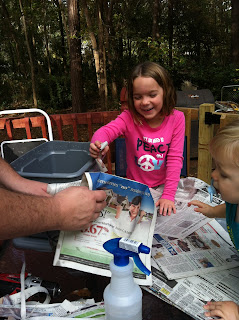That day came this week when my daughter decided to do a project with worms for her science fair experiment. We got a small container of 30 red worms so that she could test what material (rock, sand, soil, leaves) they preferred.
 |
| Red worms (Eisenia hortensis) |
After we tested them we needed to do something with them so I used it as an excuse to make my worm bin. Since worms eat about half their weight in food scraps each day 30 is not really enough so I will most likely get more. They will also multiply on their own. In the mean time I am making sure to only give them a small amount of our food scraps and the rest will either go to the chickens or into the regular compost bin.
 |
| This worm bin is so easy even a seven year old can do it (with adult supervision). |
 |
| Shredded wet news paper serves as bedding while coffee grounds and filter serve as food. I later added some sand after remembering that the worms need it for their crops where they grind their food. |
 |
| I put the bins out in a sheltered part of the deck. The undrilled cover is beneath to catch moisture and vermicompost "tea". This bin is small enough it could also be kept in the kitchen, pantry or garage. |
Some additional resources that might come in handy:
Ladybird Organics and Monticello Vineyards is a source for worms. If you don't want to make your own worm bin you can also buy worm castings from them. I have bought their castings at Tallahassee Native Nurseries and through Turkey Hill Farm.
Worms Eat my Garbage was a book I used when I was vermicomposting in grad school and I found it to be very helpful.


No comments:
Post a Comment